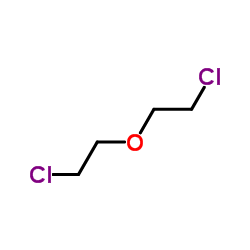Biodegradation of bis(2-chloroethyl) ether by Xanthobacter sp. strain ENV481.
Kevin McClay, Charles E Schaefer, Simon Vainberg, Robert J Steffan
文献索引:Appl. Environ. Microbiol. 73(21) , 6870-5, (2007)
全文:HTML全文
摘要
Degradation of bis(2-chloroethyl) ether (BCEE) was observed to occur in two bacterial strains. Strain ENV481, a Xanthobacter sp. strain, was isolated by enrichment culturing of samples from a Superfund site located in the northeastern United States. The strain was able to grow on BCEE or 2-chloroethylethyl ether as the sole source of carbon and energy. BCEE degradation in strain ENV481 was facilitated by sequential dehalogenation reactions resulting in the formation of 2-(2-chloroethoxy)ethanol and diethylene glycol (DEG), respectively. 2-Hydroxyethoxyacetic acid was detected as a product of DEG catabolism by the strain. Degradation of BCEE by strain ENV481 was independent of oxygen, and the strain was not able to grow on a mixture of benzene, ethylbenzene, toluene, and xylenes, other prevalent contaminants at the site. Another bacterial isolate, Pseudonocardia sp. strain ENV478 (S. Vainberg et al., Appl. Environ. Microbiol. 72:5218-5224, 2006), degraded BCEE after growth on tetrahydrofuran or propane but was not able to grow on BCEE as a sole carbon source. BCEE degradation by strain ENV478 appeared to be facilitated by a monooxygenase-mediated O-dealkylation mechanism, and it resulted in the accumulation of 2-chloroacetic acid that was not readily degraded by the strain.
相关化合物
| 结构式 | 名称/CAS号 | 分子式 | 全部文献 |
|---|---|---|---|
 |
二氯乙基醚
CAS:111-44-4 |
C4H8Cl2O |
|
Carcinogenicity tests of certain environmental and industria...
1981-07-01 [J. Natl. Cancer Inst. 67(1) , 75-88, (1981)] |
|
Thiodiglycolic acid: a major metabolite of bis(2-chloroethyl...
1979-01-01 [Toxicol. Appl. Pharmacol. 47(1) , 23-34, (1979)] |
|
Bis(2-chloroethyl)ether.
1999-01-01 [IARC Monogr. Eval. Carcinog. Risks Hum. 71 Pt 3 , 1265-9, (1999)] |
|
[Medical topics: bischloromethyl ether and lung cancer].
1985-12-01 [Kango. 37(14) , 82, (1985)] |
|
Treatment of persistent organic compounds by integrated adva...
2009-01-01 [Water Res. 43(16) , 3910-21, (2009)] |